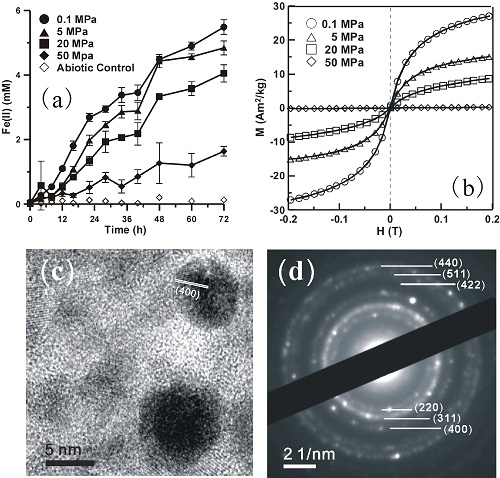Iron reduction and mineralization of deep-sea iron reducing bacteriumk, Shewanella piezotolerans WP3 at elevated hydrostatic pressuresUpdate time:12 10, 2013
Ph. D. student WU Wenfang and her teacher PAN Yongxin systematically examine iron reduction and concomitant biomineralization of a deep-sea iron reducing bacterium (IRB), Shewanella piezotolerans WP3, at different hydrostatic pressures. Their results indicate that bacterial iron reduction and induced biomineralization are influenced by hydrostatic pressure. Specifically, the iron reduction rate and extent consistently decreases with the increase in hydrostatic pressure. By extrapolation, the iron reduction rate should drop to zero by ~68 MPa, which suggests a possible shut-off of enzymatic iron reduction of WP3 at this pressure. Nanosized superparamagnetic magnetite minerals are formed under all the experimental pressures; nevertheless, even as magnetite production decreases, the crystallinity and grain size of magnetite minerals increase at higher pressure. These results imply the IRB may play an important role in iron reduction, biomineralization, and biogeochemical cycling in deep-sea environments. Fig.1. Time and pressure dependences of iron reduction (Fe(II) concentration) by WP3 under hydrostatic pressures (a), biominerals were precipitated by WP3 under hydrostatic pressures (b), high-resolution transmission electron microscopy images of the products (c,d). (Image by WU) Wu.et.al. Iron reduction and mineralization of deep-sea iron reducing bacterium, Shewanella piezotolerans WP3 at elevated hydrostatic pressures. Geobiology, 2013, 11: 593-601
|
Contact
Related Articles
Reference
|
-
SIMSSecondary Ion Mass Spectrometer Laboratory
-
MC-ICPMSMultiple-collector ICPMS Laboratory
-
EM & TEMElectron Microprobe and Transmission Electron Microscope Laboratory
-
SISolid Isotope Laboratory
-
StIStable Isotope Laboratory
-
RMPARock-Mineral Preparation and Analysis
-
AAH40Ar/39Ar & (U-Th)/He Laboratory
-
EMLElectron Microscopy Laboratory
-
USCLUranium Series Chronology Laboratory
-
SASeismic Array Laboratory
-
SEELaboratory of Space Environment Exploration Laboratory
-
PGPaleomagnetism and Geochronology Laboratory
-
BioMNSFrance-China Bio-mineralization and Nano-structure Laboratory

 Print
Print Close
Close
